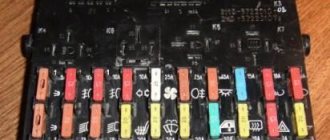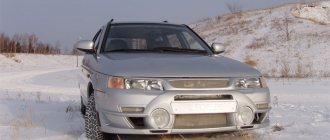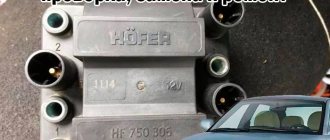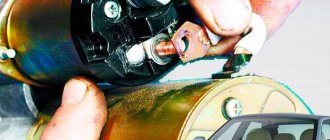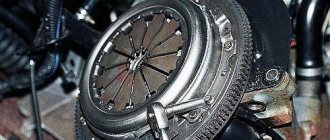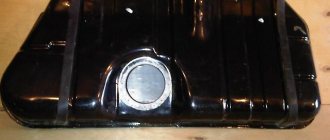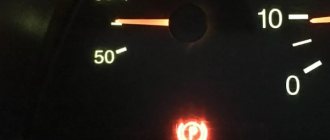The car begins to twitch when the crankshaft rotation speed changes sharply, and this happens even when the gas pedal is in its normal state. Of course, such symptoms will cause discomfort for any driver. And before you do anything, you need to identify the cause of the problem.
During the start
Most often, when starting from a standstill, the highest stage of the jerk is observed - failure, that is, a very significant delay in the engine’s response to the pressed gas pedal. It happens that the engine stalls. It’s especially unpleasant when you’re standing, for example, in front of a traffic light, and someone behind you is already honking, and you’re frantically starting the car again.
A jerk when starting off occurs when the ECU (electronic control unit) gives a signal to start opening the throttle valve, that is, when transitioning from the XX mode to the driving mode.
You can read about common throttle valve malfunctions in this material: https://vazweb.ru/desyatka/pitanie/drosselnaya-zaslonka.html
Throttle position sensor
In this case, the amount of fuel supplied through the injectors should increase, which does not occur if there is insufficient pressure in the fuel line.
Potential culprits for the car moving jerkily when starting off:
- fuel pump, which is about to completely fail. This is evidenced by its peculiar periodic “howling” or an increase in its noise. The pump on an injection engine is listened to even before the engine itself is started - it is turned on initially from the battery, starting to pump fuel before turning on the starter. It is located inside the gas tank, so it becomes almost inaudible once the engine is running. In carburetor cars, the fuel pump is under the hood, you can hear it even when the engine is running;
- The fuel pump mesh is clogged with foreign particles that enter the gas tank along with low-quality gasoline at the gas station, or are formed in the tank itself due to condensation. This is why the gas tank should be flushed periodically;
- fuel filter, which is located under the hood. It also needs to be changed periodically;
- pressure regulator. To replace it, you will need to remove and disassemble the fuel pump.
The first step is to check what pressure the fuel supply system produces. The check is carried out using a pressure gauge. It connects to a fitting located on the fuel rail (under the hood). We cannot give uniform readings, since it is different on different engines.
For some, a pressure below 325 kPa can be considered normal, while for others it is 400 kPa. That is, you need to look specifically at your instruction manual.
Engine power system
If the pressure gauge readings are too high, it means there is a malfunction in the fuel pressure regulator. If the readings are too low (less than 284 or 364 kPa, again, depending on the engine), replacing the fuel filter will help.
Second reason - Fuel pump
Unfortunately, there is no warning that your fuel pump is about to fail. The first time you notice any problems is only after the car stalls. And with this malfunction, the car cannot be started again.
The serviceability of the fuel pump can be determined by a characteristic slight buzzing sound when the engine starts. If you don't hear any noise from the fuel tank when you try to start your car, it's likely that your fuel pump has failed. Since the car will not move with this problem, all you can do is tow the car to a car service center.
While driving
It is also an unpleasant situation when the car has jerks and dips during acceleration. This can happen both when driving and when starting off. A particularly unpleasant, or even dangerous, situation can arise while driving, for example, when a car is about to overtake, and then there is a sudden failure.
The causes of jerks during acceleration can be both those already mentioned and slightly different ones:
- If you have a carbureted car that jerks when accelerating, this may indicate that the ignition is too early. You need to set the lead angle. And checking the ignition timing is quite simple: at speed 4, accelerate to 50 km/h and brake sharply. If detonation lasts 1-2 seconds, then the ignition is set perfectly, the reason is not there;
- on “injectors” everything is controlled electronically. There, the jerking while driving and during acceleration may be due to the mixture being too lean. But this should be shown by diagnostics in the service. If the sensors “know about this, but are silent,” then it is quite possible that they themselves are faulty and must be replaced.
External and internal CV joints
The next reason why the car jerks when starting off may be the inner and outer CV joints.
Internal CV joints transmit forces from the box to the car's axle shafts, and then to the wheels, which makes them quite important elements in the suspension system. Considering that these parts are systematically subjected to heavy loads, they may fail. The presence of a malfunction can be determined by the following signs:
- The CV joint turns when starting to move and there is play. Because of this, the car may jerk when starting from a stop.
- On the road, the CV joint may knock. Moreover, the road can be perfectly smooth.
- When turning, you can hear the crunch of the outer CV joints; when they wear out, they can also turn and create jerks when the car starts moving.
- Outer CV joints most often fail due to driving on bad and uneven roads.
You can read about CV joint failures and their repair on this page, where we described in more detail the causes of CV joint failures and how to diagnose them.
It follows that the first malfunction, due to which the VAZ-2114 car jerks when starting off, can be the CV joints. They are the first to be checked at a service station when a driver contacts a mechanic with a similar problem. Replacing these elements is quick, easy and most often does not cost a lot of money if we are talking about a domestic car and not a rare foreign car. Moreover, some car owners can replace the CV joints themselves; for this you will need a pit in the garage, a small set of tools and new CV joints, which are sold in almost any car store.
Jerks when cold
Many owners of the VAZ 2110 note that jerks occur when cold, and after warming up, the car gets into a rhythm while driving and stops “sausaging”. The main reason in this case is called a lean mixture, due to the fact that air is sucked in at idle. Or one of the sensors “died”.
If dips often occur when cold (as well as when driving), in addition to everything already listed, you need to check:
- spark plugs - if they have heavy carbon deposits, and even make poor contact with the wires, this needs to be corrected urgently. In the first case - by replacement, in the second, by cleaning and strengthening contacts;
- high voltage wires. Checked with an ohmmeter (multimeter). But if they even look old and shabby, it’s better to just replace them all at once;
- ignition coil. You need to check the armored wires and the ignition module while wearing rubber gloves, otherwise you may get a slight electric shock if there is a break;
- The timing belt can jump a couple of teeth, then when cold there may well be failures. Therefore, check whether the marks on the pulleys match. If not, the belt must be removed and set correctly;
- be sure to check the oxygen sensors (OS); mass air flow (MAF); idle air regulator (IAC), if a malfunction is detected, replace them;
- filters. In principle, they need to be checked first, even before serious damage occurs. Air and fuel filters are designed to give cars a clean mixture. That is, they take on all the debris particles, so they become clogged, worsening the dynamics of the car, and also increasing fuel consumption. They need to be changed regularly.
If you have checked everything, tried to fix it, but nothing helps, you need to look for the reason only in the engine itself.
It is possible that the fuel injectors in a fuel-injected vehicle are clogged. Then you will need professional diagnostics in the service.
You should not miss one more point, because of which, when cold, as well as when driving, metamorphoses such as twitching can occur with the car: did you put the right gasoline in it? Advice to all car enthusiasts is always relevant: if possible, refuel at a reliable, proven gas station. Low-quality fuel can not only cause jerking, but also damage not only the fuel pump, but the entire engine.
Source
What to do if the car stalls and won’t start
If the car stalls on the road, you will not always be able to cope with this frequently occurring problem. Check whether your vehicle poses a risk of accidents or interferes with other road users
If trouble occurs in the middle of the road, it is important to try to roll the vehicle to the side of the road. Be sure to put up an "Emergency Stop" sign
Start by checking the fuel level in the tank. Very often the car stalls only because you did not refuel your iron horse in time.
Please note that even the most complex measuring instruments have a certain error in the indicators given. It’s better to add some fuel to the tank from a canister and try starting your car again
If you did not achieve your goal, then the cause of the incident lies in something else.
Next, you need to check whether the spark plugs are producing a spark. The contacts may come loose or oxidize due to humidity. In this case, carefully disconnect the plugs and then connect them back
If oxidation occurs, the contacts will have to be carefully cleaned
If the spark plugs are filled with gasoline, dry them. Then blow out the cylinders. To do this, just turn on the starter. If they are flooded with gasoline again, you will have to use the help of other car owners or resort to evacuation services. Also, the spark may disappear if the spark plugs have exhausted their service life or become damp.
If there is a spark, but the engine still does not start, check to see if an element such as a fuse has blown. Always carry spare spark plugs and other parts that are at risk of failure. You can try to restore a blown fuse using a strip of cleaned wire. Additionally, examine the control unit and carefully wipe it outside and inside if you notice moisture there.
If the starter fails, there is no point in turning it. As long as there is residual charge in the battery, there is a possibility that you will be able to start while driving. You need to push the car if the road goes downhill or use a cable to attach yourself to another car.
If you are unlucky and the fuel pump is “covered,” then no fuel flows into the carburetor and it cannot work. The simplest option: a steam plug has formed. Just wait for it to evaporate on its own. It is enough for the fuel pump to cool itself. In all other cases, you will have to get to the service.
Source
Diagnostics using ODB-2 scanner
Since there are many reasons for the malfunction, first of all it is worth carrying out a comprehensive diagnosis of the car. This can be done most quickly using an ODB2 scanner.
Scan Tool Pro Black Edition
A special feature of Scan Tool Pro is the diagnosis of not only the engine, but also other vehicle components (gearbox, transmission, abs, etc.). After reading the errors, you will most likely know exactly the cause of the malfunction (problem in the pump, pressure regulator, lean fuel mixture, malfunction of one of the sensors), after which you should first pay attention to this element. The scanner is compatible with most models of the domestic automobile industry since 1993 and is designed specifically for the CIS - error codes with their interpretation are displayed in Russian.
At the start
At the very beginning of the movement, such problems can begin, and here they will be the biggest jerks.
That is, the engine seems to be late in responding to the pressed gas pedal. It may even stall completely, this will happen if the control unit gives a signal to the throttle valve to open. And there are reasons for this:
- The fuel pump is running low and it begins to hum or make noise. It is necessary to listen to the engine on the injector before starting; it cannot be heard when the engine is running, since it is located in the fuel tank. On the carburetor, the pump is located under the hood, so it can be heard even when the engine is running.
- There is a special mesh on the fuel pump that periodically gets clogged, in which case you need to flush the gas tank or change this mesh.
- The fuel filter needs to be changed, also after a certain period of time.
- The pressure regulator may fail; it is located in the fuel pump; it is disassembled and the regulator is replaced.
Of course, at the very beginning it is worth checking the pressure in the fuel supply system; a pressure gauge is used for this. It must be connected to the fitting on the fuel system and watch the indicators of the device. Full readings cannot be shown, as they will be different on different engines. One thing we can say is that readings above one are not very good. The dynamics of the device readings can be found in the car manual; it states what the readings should be during normal operation of the car.
But the readings can be too high and here you can immediately answer that the reason for this is the pressure regulator, but it is better to replace it immediately; repairs are not practical here.
Why does it start and stall?
If you turn on the logic, there may be several main reasons why the engine stalled after starting:
- insufficient amount of fuel;
- exhaust system malfunctions;
- failures in the formation of the air-fuel mixture and its supply to the injectors.
It can be assumed that the cause is faulty spark plugs or a clogged air filter. But spark plugs do not all fail at once. If one spark plug does not work, the engine starts to stall, but this will not cause it to stall. To clog the filter to such an extent that it is unable to pass air through itself requires a lot of effort. When there is no air supply, the engine will not start at all, and even if it does start, the thrust will drop significantly. Traveling would be difficult, if not impossible.
Insufficient fuel supply
The symptom is simple: after starting, the engine runs for 5–10 seconds and stalls. In most cases, the cause is the fuel pump located in the fuel tank. To be precise, the problem is a clogged fine filter or mesh. This detail, insignificant at first glance, does not allow dirt particles to enter the fuel line, which, like water in the gas tank, is abundant (especially on cars with a mileage of 50,000 or more).
In summer, the water and other substances in the tank are liquid and can pass into the main line, but in winter they often turn into ice on the mesh filter. This causes the fuel pump to be unable to pump enough fuel to run the engine. Therefore, it turns out that the pump manages to pump a little fuel, and this is just enough to start the engine, but no more. To eliminate this problem, it is enough to replace or clean the fuel pump mesh.
Exhaust system malfunctions
Everything is simple here: if you close the pipe tightly, the engine will stall after some time. Even if you start it again, it will run for a few seconds and then die again. This happens because the exhaust gases have nowhere to go: they cannot get out, and fall through the exhaust manifold back into the combustion chambers. There, the gases mix with the air-fuel mixture, ignition becomes impossible, and the engine stalls.
Exhaust gases are not removed for several reasons:
- catalyst malfunction (can also be heavily contaminated);
- water in the muffler.
The situation with a clogged catalyst is rare. To do this, the water in it needs to freeze, but this is unlikely.
But water in the muffler happens quite often. It freezes in winter and exhaust gases cannot escape. There are few reasons why water gets in. Basically, this is a broken cylinder head, which causes antifreeze to enter the exhaust system and, mixing with condensate, freezes. Although, if the cylinder head gasket is punctured, the problem of ice in the muffler will seem like a trifle, since more serious repairs await.
Incorrect fuel/air mixture
Such situations occur frequently. In this case, the engine either does not start at all, or runs erratically. There are few reasons, these are:
- incorrect operation of the throttle assembly;
- air intake in addition to the air duct in front of the air filter (suction).
The throttle valve is directly involved in the formation of the fuel mixture, and disruption of its functioning leads to malfunctions of the power plant. The air leak makes the mixture too lean, and the engine cannot work on it, which is why it stalls. To eliminate these problems, you need to clean the throttle assembly (or replace it if it is faulty) and look for the location of the air leak.
When driving
Here, too, not everyone will like it when the car starts to twitch in motion.
There may also be a dangerous situation on the road when another vehicle is overtaken and at that moment a failure occurs. There are also a number of reasons for this, but the above symptoms should not be dismissed:
- On a carburetor car this can happen if the ignition is set to early. This can be easily checked, accelerate immediately at 4 speeds to 50 km/h and at the same time brake sharply, detonation should be no more than 2 seconds, then everything is in order.
- In injection engines, everything rests with the car’s electrics; here jerks can occur if the mixture is too lean. But this can only be checked by specialists during diagnosis.
When accelerating the car, the engine jerks: how to find the cause of the problem
Quite often, when operating an injection or carburetor car, you may encounter that the engine jerks during acceleration. In other words, after sharply pressing the gas pedal, there is no clear response from the power unit, a pause-failure occurs, the speed increases in jerks, etc.
These jerks are a rapid change in the crankshaft speed, regardless of the position of the gas pedal and the degree of pressure on the accelerator. As a rule, such jerks follow in series, causing the engine to jerk.
Cold jerks
Some VAZ 2110 drivers say that the jerking starts when it’s cold, and when the car warms up, they disappear.
The most important reason is a lean mixture and therefore air is sucked in at idle. But it is possible that one of the sensors has failed. If such jerks begin to repeat periodically, whether idling or while driving, you need to check:
- Candles, when they are heavily sooted, they lose contact with the wires, and this needs to be corrected urgently. They should be replaced or the contacts should be cleaned and secured.
- High-voltage wires should be checked with a multimeter, and if they have lost their appearance, it is best to completely replace them.
- The ignition coil, here you need to check the armored wires and the ignition module itself. But the test should be carried out with rubber gloves, otherwise you may get an electric shock.
- The timing belt often jumps several teeth and jerking may occur when running cold. First of all, you should check the marks, and if the belt has slipped, you need to remove it and install it as expected.
- Be sure to check all the sensors on the car; if there are faulty ones, then urgently replace them.
- The filter is checked first, because the air and fuel filters are responsible for supplying a clean mixture to the car engine. Here, fuel consumption immediately increases and they need to be changed after a certain period of time.



